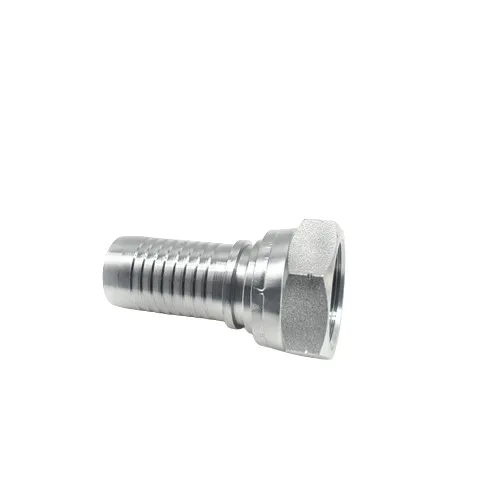Detailed Overview of Coupling Adapter Hydraulic Fittings
2024-07-25
Coupling adapters for hydraulic fittings are crucial components in hydraulic systems, used to connect different hydraulic hoses or components, allowing for flexible and efficient fluid transfer. They play a vital role in ensuring that hydraulic systems operate smoothly and effectively. Here’s a detailed overview of coupling adapters for hydraulic fittings:
Features
1. Design and Construction:
- Material: Typically made from high-strength materials such as steel, stainless steel, brass, or aluminum to withstand high pressure and corrosive environments.
- Type: Available in various designs including threaded, flanged, quick-connect, and swivel types, depending on the application requirements.
2. Thread Types:
- NPT (National Pipe Tapered): Commonly used for pipe threads with a tapered design that provides a seal as the threads are tightened.
- BSP (British Standard Pipe): Includes BSPP (parallel) and BSPT (tapered), used for threaded connections in hydraulic systems.
- JIC (Joint Industry Council): Features a 37-degree flare, used in high-pressure hydraulic applications.
3. Coupling Mechanism:
- Quick-Connect: Allows for fast and easy connection and disconnection without tools, commonly used in systems requiring frequent hose changes.
- Threaded: Uses internal and external threads to create a secure connection, suitable for permanent or semi-permanent installations.
- Swivel: Includes a rotating mechanism to accommodate movement and reduce stress on the hose and fittings.
4. Pressure Rating:
- High Pressure: Designed to handle high-pressure hydraulic fluids, with pressure ratings often specified by the manufacturer.
- Burst Pressure: Rated to withstand pressure higher than the normal operating pressure to ensure safety and durability.
5. Seal Types:
- O-Ring: Provides a seal between the adapter and the hydraulic component to prevent leaks.
- Flat Face: Uses a flat surface for sealing, often with a metal-to-metal or elastomeric seal.
Benefits
1. Versatility:
- Adaptability: Allows for the connection of various types of hydraulic hoses and components with different thread types and sizes, facilitating system flexibility.
- Compatibility: Can be used to adapt between different hydraulic systems, enabling integration of components from different manufacturers or standards.
2. Efficiency:
- Reduced Downtime: Quick-connect and easy-to-install adapters minimize downtime during maintenance or component replacement.
- Improved Flow: Designed to minimize pressure loss and fluid turbulence, ensuring efficient fluid transfer.
3. Safety:
- Leak Prevention: Proper sealing mechanisms prevent leaks and ensure the safe transfer of hydraulic fluids.
- High Pressure Handling: Rated for high pressures, reducing the risk of failure or rupture in high-pressure hydraulic systems.
4. Durability:
- Robust Construction: Made from durable materials that resist wear, corrosion, and mechanical stress, extending the lifespan of the hydraulic system.
Types of Coupling Adapters
1. Straight Couplings:
- Design: Connects two hoses or components in a straight line.
- Application: Used when the connection does not require alignment adjustment.
2. Elbow Adapters:
- Design: Provides a 90-degree or other angled connection between hoses or components.
- Application: Used to change the direction of the hydraulic flow or navigate around obstacles.
3. Tee and Cross Adapters:
- Design: Allows connections between three or four hydraulic lines at a junction point.
- Application: Used for splitting or combining hydraulic flow in multiple directions.
4. Quick-Connect Couplings:
- Design: Enables rapid connection and disconnection without tools.
- Application: Ideal for applications requiring frequent changes or maintenance of hydraulic hoses.
5. Swivel Adapters:
- Design: Allows for rotation to accommodate movement and reduce stress on connections.
- Application: Used in applications where flexibility and movement are required.
Applications
1. Construction:
- Heavy Equipment: Used in excavators, loaders, and other construction machinery to connect hydraulic hoses and components.
2. Agriculture:
- Farm Equipment: Connects hydraulic systems in tractors, harvesters, and other agricultural machinery.
3. Industrial Machinery:
- Manufacturing: Used in hydraulic presses, conveyors, and other industrial equipment for efficient fluid transfer.
4. Automotive:
- Repair and Maintenance: Utilized in hydraulic systems of vehicles for maintenance and repair applications.
5. Aerospace and Defense:
- Aircraft Systems: Used in hydraulic systems of aircraft and military vehicles for critical operations.
Considerations
1. Compatibility:
- Thread Size and Type: Ensure that the adapter matches the thread size and type of the hoses or components being connected.
- Material Compatibility: Choose materials that are compatible with the hydraulic fluid and operating environment.
2. Pressure and Temperature Ratings:
- Operating Conditions: Verify that the adapter’s pressure and temperature ratings are suitable for the operating conditions of the hydraulic system.
3. Seal Integrity:
- Proper Sealing: Ensure that seals are intact and in good condition to prevent leaks and ensure safe operation.
4. Installation and Maintenance:
- Proper Installation: Follow manufacturer instructions for installation to ensure a secure and leak-free connection.
- Regular Inspection: Inspect adapters regularly for signs of wear, damage, or leakage and replace as needed.
Conclusion
Coupling adapters for hydraulic fittings are essential for connecting and adapting hydraulic systems, offering versatility, efficiency, and safety in various applications. Selecting the right type and size of adapter, ensuring compatibility, and maintaining proper installation and maintenance practices are crucial for optimal performance and reliability of hydraulic systems.



